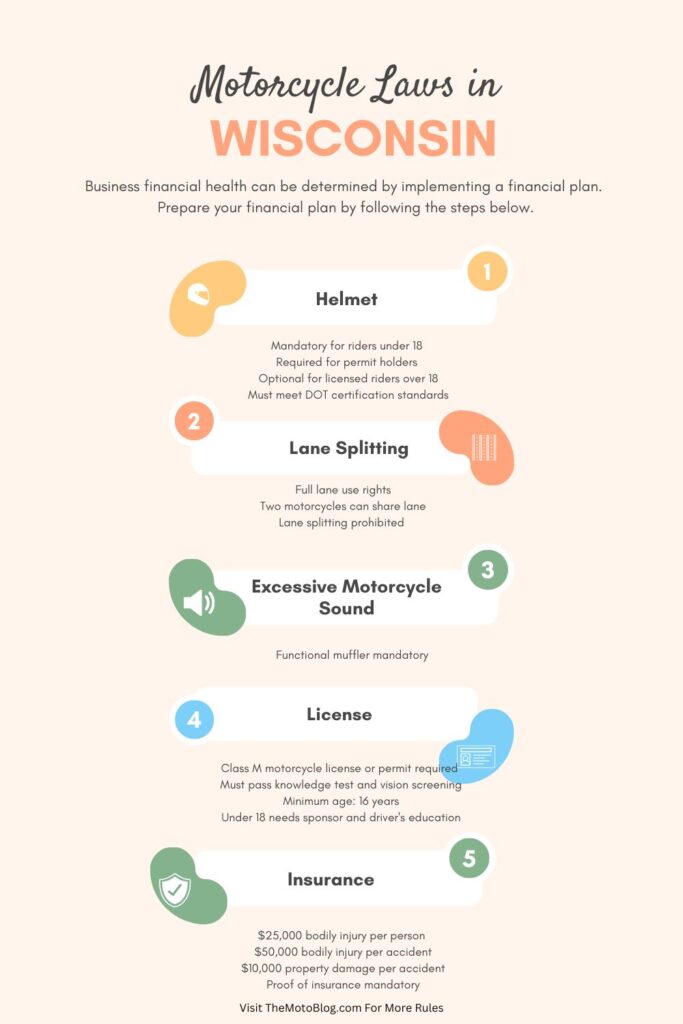Motorcycle Laws in Wisconsin: An Expert’s Insightful Guide
Wisconsin’s motorcycle laws strike a careful balance between rider freedom and public safety on its scenic roadways. Bordered by states with varying motorcycle regulations, Wisconsin shares its northern border with Michigan’s comprehensive motorcycle laws and its western border with Minnesota’s structured regulations. Understanding these laws is crucial for both residents and visitors exploring the state’s diverse terrain, from the Great Lakes coastline to the rolling hills of the Driftless Area.
Wisconsin’s motorcycle regulations maintain standards similar to neighboring Iowa and Illinois, while incorporating unique provisions that reflect the state’s commitment to motorcycle safety and rider autonomy.

| Rule Category | Requirements |
|---|---|
| License Requirements | – Class M motorcycle license or permit required – Must pass knowledge test and vision screening – Minimum age: 16 years – Under 18 needs sponsor and driver’s education |
| Helmet Laws | – Mandatory for riders under 18 – Required for permit holders – Optional for licensed riders over 18 – Must meet DOT certification standards |
| Eye Protection | – Mandatory for all riders – Face shield, glasses, or goggles acceptable – Not required with 15-inch+ windshield – No night tinting allowed |
| Lane Usage | – Full lane use rights – Two motorcycles can share lane – Lane splitting prohibited – Maximum handlebar height: 30 inches |
| Lighting | – Headlight required at all times – Maximum 2 headlamps allowed – Turn signals mandatory – Functioning muffler required |
| Insurance | – $25,000 bodily injury per person – $50,000 bodily injury per accident – $10,000 property damage per accident – Proof of insurance mandatory |
| Passenger Rules | – No minimum age requirement – Must have passenger seat – Must have passenger footrests – Passenger must reach footrests |
| Registration | – State registration required – Valid registration stickers displayed – Separate off-road registration needed – Proof of insurance required |
| Equipment | – At least one rear-view mirror – Turn signals required – Passenger seat (if carrying passenger) – Functional muffler mandatory |
| Group Riding | – Maximum two motorcycles side-by-side – Must have mutual consent – Full lane rights apply – Standard traffic laws apply |
Licensing Requirements
To legally operate a motorcycle in Wisconsin, riders must obtain a Class M motorcycle license or instruction permit. The process includes passing a motorcycle knowledge test, sign test, and vision screening. For riders under 18, a sponsor and proof of driver’s education completion are mandatory.
Instruction Permits
- Valid for 6 months
- Renewable twice
- Mandatory helmet use during permit period
Helmet and Safety Equipment Laws
Wisconsin’s helmet laws are more lenient than some neighboring states like Michigan’s motorcycle laws. Helmets are only mandatory for:
- Riders under 18
- Instruction permit holders
Eye Protection Requirements
All riders must use eye protection unless their windshield extends 15 inches above the handlebars. Acceptable forms include:
- Face shield
- Glasses
- Goggles
Operating Rules and Regulations
Lane Usage and Positioning
- Motorcyclists are entitled to full lane use
- Two motorcycles can share a lane side-by-side with mutual consent
- Lane splitting is prohibited
Equipment Requirements
- Headlight must be on at all times
- Maximum handlebar height: 30 inches above seat
- Mandatory turn signals
- At least one rear-view mirror
Insurance Requirements
Wisconsin requires minimum liability coverage of:
- $25,000 bodily injury per person
- $50,000 bodily injury per accident
- $10,000 property damage per accident
Passenger Laws
Wisconsin’s passenger regulations require:
- Dedicated passenger seat
- Passenger footrests
- Passenger must be able to reach footrests
- No minimum age requirement
Registration and Documentation
All motorcycles must be registered with the state and display valid registration stickers. Riders must carry proof of insurance at all times.
Traffic Laws and Special Circumstances
Group riding allows a maximum of two motorcycles side-by-side in a single lane. For off-road motorcycles, separate registration is required, and different rules apply for agricultural use.
Wisconsin’s motorcycle laws and regulations create a framework that promotes both safety and enjoyment for riders exploring the state’s diverse landscapes. While sharing some common elements with its neighbors like Minnesota’s motorcycle requirements and Michigan’s safety standards, Wisconsin maintains its own distinct approach to motorcycle regulation.
The state’s comprehensive legal framework ensures riders can safely navigate everything from urban streets to rural backroads. Whether you’re a resident or visitor, understanding and following these regulations is essential for a safe and legal riding experience in Wisconsin. For those planning cross-state adventures, it’s worth noting how these laws complement those of neighboring states like Iowa and Illinois, especially when planning longer tours through the Upper Midwest.
Motorcycle Laws in the US By States
If you liked this article, then please subscribe to our YouTube Channel for more Bike Videos. You can also find us on Instagram, Twitter and Facebook.
Disclosure: As an Amazon Associate, I earn from qualifying purchases. Read more about Amazon Affiliate Disclaimer.

Vishwanath Mathpati
I am Vishwanath Mathpati, a full-time Blogger and Motorcyclist from Bidar, Karnataka. I love writing about my Motorcycles Stories and Riding Gears on this blog.
Know More About Me.







